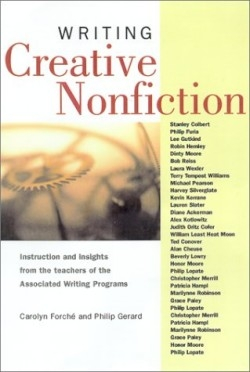Writing Creative Nonfiction
Mark Twain once said,
“Get your facts first, and then you can distort them as much as you please.” The essays in this collection help the writer of creative nonfiction know how to use the facts and effectively infuse a piece with the stylistic devices of literary works, such as suspenseful plot and lyrical tone, without crossing the boundary into pure fiction.
The book is divided into three sections. The first consists of instructive essays, written by current writers who also teach this genre, including pieces that explore biography, memoir, and even war writing using braided narrative, investigative research, and effective humor. Practical advice is offered on surviving overseas in peaceful as well as war-torn countries, sending attention-grabbing proposals to editors, and avoiding legal traps. The legality is explained by two First Amendment attorneys, who warn that no matter how thorough the fact checking, anyone can be sued. Therefore, it is important to know one’s rights and proceed with caution, but also to avoid the kind of self-censorship that will damage the vitality of the story.
The second section covers what happens after publication. It includes discussions on the reactions writers received from their work. Two of these essays are juxtaposed against the actual critiques. One particular review, by James Wolcott, slams creative nonfiction as a whole, criticizing Lee Gutkind, one of the major proponents of this genre, for being the “godfather” of it. Gutkind’s thorough response follows Wolcott’s attack.
The third section consists of a “Creative Nonfiction Reader,” which includes works cited in the first two sections, including a biography of one woman’s artist grandmother who slipped into madness, and a portrait of patricide in a rural town in Oklahoma.
The editors, a poet and a novelist who both teach in MFA programs, did an excellent job of choosing essays that present a well-rounded picture not only of what makes up creative nonfiction, but how to avoid the pitfalls often encountered while writing it, attempting to have it published, and in the aftermath of publication. The inclusion of the cited works at the end helps to flesh out the meanings of the instructive pieces.
This book would prove a valuable tool to any beginning writer interested in pursuing this genre or as a text in classes on creative nonfiction. Exercises are included at the end of each instructive essay to facilitate classroom use, or for use by the motivated individual reader/writer.
Disclosure: This article is not an endorsement, but a review. The publisher of this book provided free copies of the book to have their book reviewed by a professional reviewer. No fee was paid by the publisher for this review. Foreword Reviews only recommends books that we love. Foreword Magazine, Inc. is disclosing this in accordance with the Federal Trade Commission’s 16 CFR, Part 255.

